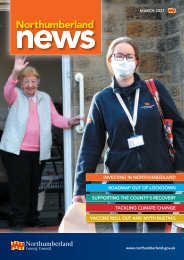Top tips for staying safe
Top tips for staying safe and well in your home. Making Northumberland Safer.
Top tips for staying safe and well in your home.
Making Northumberland Safer.
Create successful ePaper yourself
Turn your PDF publications into a flip-book with our unique Google optimized e-Paper software.
Northumberland<br />
Fire and Rescue Service<br />
<strong>Top</strong> <strong>tips</strong> <strong>for</strong> <strong>staying</strong><br />
SAFE AND WELL<br />
IN YOUR HOME<br />
Making Northumberland Safer
FIRE SAFETY<br />
BEGINS AT HOME<br />
A fire in your home can be devastating, even fatal.<br />
Once a fire starts it can spread rapidly putting you and<br />
your loved ones at risk. While the dangers of fire are<br />
very real, there is a lot you can do to protect yourself,<br />
your family and your home.<br />
Northumberland Fire and Rescue Service is committed to<br />
keeping communities <strong>safe</strong> through sharing home fire <strong>safe</strong>ty<br />
strategies and in<strong>for</strong>mation with our communities. Young<br />
children, older people, people with a disability and smokers<br />
are at a higher risk of being injured or not surviving a fire in<br />
their home.<br />
The advice in this booklet will help you learn how you can<br />
prevent house fires and keep you and your loved ones <strong>safe</strong>.<br />
Making your home fire <strong>safe</strong> and knowing what to do in the<br />
event of a fire can be the difference between life and death.<br />
Did you know? You are four times more<br />
likely to die in a fire if you don’t have<br />
a working smoke alarm.
Would you like home fire <strong>safe</strong>ty<br />
advice, or to arrange <strong>for</strong> a Safe<br />
and Wellbeing Visit from us?<br />
...YES, then follow<br />
these 3 simple steps:<br />
1<br />
Contact us on 01670 621 149 or<br />
swv.nfrs@northumberland.gov.uk<br />
2<br />
We will arrange a<br />
convenient time to<br />
call, or offer advice<br />
over the phone.<br />
3<br />
We will visit you at home if<br />
necessary, to offer you home<br />
<strong>safe</strong>ty and wellbeing advice.<br />
REMEMBER:<br />
Always ask all visitors to show<br />
their Identity Card be<strong>for</strong>e letting<br />
anyone enter your home.
SMOKE ALARMS<br />
A smoke alarm detects fire in its early stages and<br />
gives you a warning which can help save lives and<br />
your home. Northumberland Fire and Rescue visit<br />
over 7500 each year, giving advice, including how<br />
to fit and look after your smoke alarms.<br />
<strong>Top</strong> smoke alarm <strong>tips</strong> <strong>for</strong> a <strong>safe</strong>r home:<br />
1<br />
2<br />
3<br />
4<br />
5<br />
6<br />
Fit a smoke alarm on every level of<br />
your property. Hallways and landings<br />
are recommended.<br />
Make sure your alarm is not faulty by<br />
testing it monthly.<br />
Clean your smoke alarm every<br />
3 months. Use a vacuum or soft brush<br />
to remove dust particles.<br />
The ideal place <strong>for</strong> your smoke<br />
alarms is on the ceiling.<br />
If we have fitted a 10-year sealed<br />
alarm <strong>for</strong> you and it begins to chirp,<br />
please see the back of this booklet<br />
<strong>for</strong> further support.<br />
For mains smoke alarms, consult a<br />
qualified electrician <strong>for</strong> maintenance.
Avoid a fall by<br />
using a long item<br />
like a broom<br />
handle to gently<br />
test your smoke<br />
alarm!<br />
IN THE KITCHEN<br />
Leaving cooking unattended is a<br />
major cause of house fires. If you<br />
need to leave the kitchen <strong>for</strong> any<br />
reason, like answering the door or<br />
phone, always take the pans off heat.<br />
HOBS/HOT PANS<br />
✔ Keep tea towels away from<br />
the oven or hob.<br />
✔ Make sure pan handles don’t<br />
hang over another hob or stick<br />
out over the cooker top.<br />
✔ Consider replacing chip pans<br />
with a thermostat controlled<br />
deep fat fryer.<br />
✔ Never throw water over a pan of<br />
hot oil. If the pan catches fire,<br />
turn off heat, if <strong>safe</strong> to do so,<br />
leave the house and call 999.
ELECTRICAL SAFETY<br />
When was the last time you used your dishwasher or washing<br />
machine overnight? Using tumble dryers whilst asleep or out of<br />
the house can be dangerous too, as a build-up of fluff in the filter<br />
can cause fires. We recommend that you clean your dishwasher<br />
filters regularly and avoid using washers/dryers overnight.<br />
Remember to switch off appliances when not in use.<br />
See our electrical <strong>safe</strong>ty <strong>tips</strong> below <strong>for</strong> a <strong>safe</strong>r home:<br />
1<br />
2<br />
3<br />
4<br />
5<br />
Stick to one plug per socket to<br />
avoid overloading.<br />
Don’t run cables underneath<br />
carpets or rugs, and check leads<br />
regularly <strong>for</strong> wear and tear.<br />
Never charge mobile phones<br />
under pillows overnight.<br />
Make sure to check old cables and<br />
plugs <strong>for</strong> wear and tear and do not<br />
use any with exposed wires.<br />
Extension cables should NOT<br />
be plugged into other extension<br />
cables.
PORTABLE HEATERS<br />
✔ Always keep yourself and your items at least<br />
1 metre away from a fire or a portable heater.<br />
✔ Secure portable heaters, especially oscillating<br />
heaters, to prevent them falling over.<br />
✔ Never dry clothes over portable heaters or fire guards.<br />
SMOKING HAZARDS<br />
✔ Ensure your cigarette is fully stubbed<br />
out, and disposed of carefully.<br />
✔ Use a proper ashtray, one that can’t tip<br />
and is made of inflammable material.<br />
✔ Don’t leave lit cigarettes lying around.<br />
✔ Never smoke in bed.<br />
✔ Keep smoking materials out of reach<br />
of children.<br />
✔ Consider child-resistant lighters/<br />
match boxes.<br />
Concerns about a<br />
young person setting<br />
fires? Ask us about the<br />
Extinguish Programme.<br />
COMMUNITY SAFETY<br />
DEPARTMENT
E-CIGS AND VAPES<br />
Don't charge your Vape/E-Cig overnight, and regularly<br />
check on it when charging. Charge your Vape/E-Cig on a<br />
clean, flat surface, away from anything that could easily<br />
catch fire, and somewhere you can clearly see it.<br />
SAFE USE OF CANDLES<br />
Candles should always be secured in a proper holder,<br />
including tea lights. Always put out candles when leaving<br />
the room, especially be<strong>for</strong>e bedtime and never leave<br />
children alone with lit candles.<br />
FIREPLACE/LOG BURNERS<br />
Use a fire guard and never dry clothes over fireplace.<br />
If you have a log burner, always store your fuel well<br />
away from your burner and regularly get your<br />
chimney swept - this can prevent a build<br />
up and a fire developing. For fuel types<br />
and sweep frequency visit:<br />
www.northumberland.gov.uk/Fire/Home.aspx
HOUSEKEEPING, FIRE LOADING<br />
AND CONSUMER UNITS<br />
1<br />
2<br />
3<br />
4<br />
Keep clutter like magazines, paper and boxes to a minimum,<br />
as these will make a fire spread quicker.<br />
Excess items around your exits like bikes, boxes and toys<br />
can slow your means of escape in the event of a fire.<br />
Check your fuse board regularly <strong>for</strong> signs of physical<br />
damage and signs of overheating.<br />
Never touch exposed or damaged wiring in case it is live.<br />
If you have concerns, speak to a qualified electrician.<br />
ALCOHOL/MEDICATION<br />
Research suggests that across the UK more than<br />
50% of fire fatalities within the home involve drink<br />
or drug-related behaviour. Don’t cook when drinking<br />
or taking drugs. Be mindful that some prescription<br />
medication can make you drowsy too.<br />
Your pet’s tail can easily knock over a<br />
candle or lit cigarette, always keep lit<br />
materials well away from your pet.
WHAT’S YOUR ESCAPE PLAN?<br />
✔ Plan an escape route and make sure everyone knows<br />
how to escape.<br />
✔ Make sure exits are kept clear.<br />
✔ Make sure everyone in the property has quick access<br />
to keys <strong>for</strong> windows/doors.<br />
✔ The best route is the normal way in/out of your home.<br />
✔ Think of a second route in case the first one is blocked.<br />
✔ Review your plan if the layout of your home changes.<br />
WHAT TO DO IF YOUR ESCAPE<br />
IS BLOCKED<br />
1<br />
2<br />
3<br />
4<br />
5<br />
If you can’t get out, get everyone into one room, ideally<br />
with a window and a phone.<br />
Put bedding around the bottom of the door to block<br />
out the smoke.<br />
Call 999 then open the window and shout “HELP FIRE”.<br />
If you can’t open the window break the glass in<br />
the bottom corner. Make jagged edges <strong>safe</strong> with<br />
a towel or blanket.<br />
Use soft bedding (Not a mattress) to cushion your fall<br />
and lower yourself down carefully. Don’t jump.<br />
GET OUT, STAY OUT, CALL 999.
Cut me out and stick me somewhere visible<br />
YOUR HANDY<br />
NIGHT-TIME CHECKLIST<br />
Close all internal doors at night as this<br />
will stop a fire from spreading as quickly.<br />
Make sure exits are clear from obstacles and<br />
keys <strong>for</strong> windows and doors are kept<br />
where everyone can find them.<br />
Turn off and unplug appliances unless<br />
they are designed to be left on.<br />
Check your cooker is turned off.<br />
Do not leave washing machines,<br />
dishwashers, or tumble dryers on.<br />
Turn off heaters.<br />
Make sure cigarettes and candles<br />
are extinguished properly.
Batch Number<br />
Replace by end:<br />
FURTHER SUPPORT<br />
If we have visited your property and fitted a 10-year sealed smoke alarm,<br />
please refer to the instruction manual we left <strong>for</strong> you <strong>for</strong> guidance. If your<br />
alarm develops a fault follow these steps.<br />
1<br />
Temporarily remove alarm from ceiling<br />
Rotate the alarm anti-clockwise to remove it<br />
from the backplate fixed to the ceiling.<br />
Batch Number:<br />
Replace by end:<br />
2<br />
Find in<strong>for</strong>mation on the back of the alarm<br />
Make a note of the ‘batch number’ and ‘replace<br />
by date’ on reverse. Then re-attach the alarm to<br />
the ceiling backplate by twisting it clockwise.<br />
3 Contact the manufacturer<br />
Call the freephone number on your instruction manual<br />
<strong>for</strong> support, describe the fault and provide the in<strong>for</strong>mation<br />
from step 2. If you prefer, you can email the manufacturer<br />
or visit their website.<br />
Northumberland Fire and Rescue Service<br />
West Hart<strong>for</strong>d Business Park<br />
Cramlington NE23 3JP<br />
Tel 01670 621149<br />
www.northumberland.gov.uk/fire<br />
@NlandFRS
















